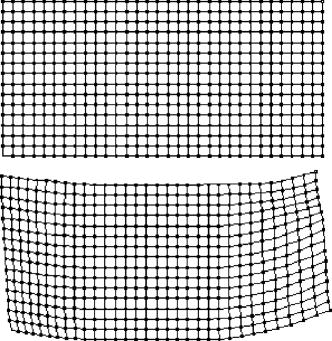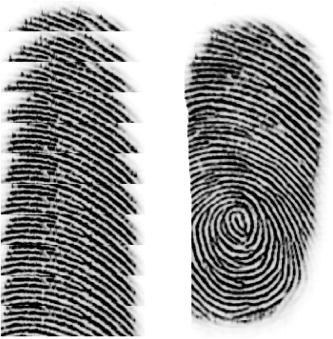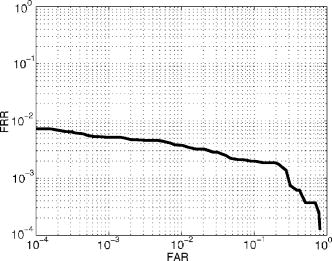|
|
1.IntroductionThe sweep fingerprint sensor, with the size of a narrow stripe, scans an image sequence of frames during a relative motion between the sensor and the finger.1 It is propagated due to its decreased area and cost, but requires the image sequence to be reliably reconstructed. In two existing state-of-the-art reconstruction methods,2, 3 nonlinear distortions are neglected and the only possible transformation between two consecutive frames is assumed to be a global translation. Therefore these methods lack robustness to the presence of distortions, and may yield seams and/or blurs in the reconstructed images. To deal with distortions, two main approaches have been reported in the literature. One accounts for the problem with the help of some mechanical guidance (e.g., force sensors) built into the sensor packaging. Unfortunately, most of the commercial fingerprint sensors do not mount force sensors and are not able to capture images at a high rate. The other addresses distortions after image sequence acquisition. There are only a few methods for modeling fingerprint distortions.4, 5 One prominent method is using minutiae correspondences as landmarks, and creating a deformation model using thin-plate splines (TPS). However, the TPS model depends on the availability of a large number of minutiae in the overlap between two consecutive frames. A minimum of four correspondence pairs is necessary to model nonlinear distortions for the TPS model. Due to the nature of swipe design of sweep fingerprint sensors, there are very few minutiae correspondences between two consecutive frames. In these cases, the TPS model cannot be used. Recently, a curvature-based elastic registration model has been proposed, which not only produces accurate and smooth solutions but also allows for an automatic rigid alignment.6 Though affine linear transformations belong to the kernel of this regularizer, the iterations to obtain the pleasing result may be quite large. In this letter, a coarse-to-fine image registration scheme is proposed to register two consecutive frames of the sweep fingerprint sequence: the block-matching method is first used for a coarse estimation of translation displacement, and the curvature-based elastic registration is then adopted for a fine estimation of nonlinear distortions. 2.Block-Matching-Based PreregistrationLet and denote two consecutive frames of a sweep fingerprint sequence . Given that and differ only by a translation displacement , their overlap satisfies: Thus, the minimum mean absolute error (MAE) between and for an block is:Then the optimal translation displacement can be evaluated:3.Curvature-Based Elastic RegistrationThe curvature-based image registration can be summarized as follows: find a mapping , which minimizes the joint criterion where Here, the regularization parameter is used to control the strength of the smoothness of the displacement versus the similarity of two consecutive frames, and “ ” is a Laplacian operator.The Euler-Lagrange equation for Eq. 4 is where is subject to the boundary conditionsHere, is the boundary of and “ ” is the spatial derivative operator.The fourth-order nonlinear partial differential equation (PDE) of Eq. 5 is known as the biharmonic equation. A popular approach to solve this PDE is to introduce an artificial time and to compute the steady state solution of the time dependent PDE. A semidiscrete time-marching method based on a real discrete cosine transformation is developed in Ref. 6, in which a finite difference approximation for the spatial derivatives is used. This leads to a linear system that can be efficiently solved within operators and is adopted in our implementation. Once two consecutive frames are registered, the reconstruction of a sweep fingerprint sequence is finished iteratively till the last frame is mosaicked. Because the block-matching method using the MAE as a similarity measurement succeeds in registering two consecutive frames with small overlap down to 5% of the frame size7 and the curvature-based elastic registration produces accurate and smooth solutions against nonlinear distortions,6 better reconstruction accuracy is expected. 4.ResultsTo evaluate the proposed registration scheme for the reconstruction, we need a database including a considerable number of sweep fingerprint sequences. Such a database is, however, not available in standard fingerprint databases (e.g., FVC2000). Therefore, we have acquired sweep fingerprint sequences of 180 fingers using a Fingerprint Cards’ FPC1031B sweep sensor (each frame with , and ) over a period of . For each finger, 10 sequences have been acquired, producing a total of 1800 sequences. In Fig. 1, the grid is used to visualize the nonlinear distortions between two consecutive frames, which can be viewed as two different observations of an elastic body, one before and one after a deformation. In Fig. 2, some consecutive frames of a sweep fingerprint sequence and the reconstructed image are illustrated. To be precise, we have chosen for our scheme the parameters , , and . In order to compare the recognition performance with existing reconstruction methods,2, 3 a straightforward method has been implemented, consisting of minutiae extraction and minutiae matching, on the reconstructed fingerprint images.8 The following indices are used to assess the recognition accuracy: (1) equal-error rate (EER), which denotes the error rate when the false acceptance rate (FAR) and the False Reject Rate (FRR) are identical; (2) receiver operating characteristic (ROC) curve, which plots the FRR against FAR at various matching thresholds. The ROC curve for the elastic matching embedded with the proposed reconstruction scheme is shown in Fig. 3 and the corresponding EER is 0.46%. Meanwhile, the EERs corresponding to the reconstruction methods proposed in Refs. 2, 3 are 0.84% and 0.92%, respectively. It is seen that the proposed coarse-to-fine registration scheme leads to a better recognition performance than the other two. Fig. 1The nonlinear distortions between two consecutive frames, one before and one after deformation.  5.ConclusionsThe reconstruction algorithm plays a vital role in image quality for the sweep fingerprint sensor. Due to the elasticity of the skin, nonlinear distortions are the most difficult problem during the reconstruction. In this letter, we propose a coarse-to-fine image registration scheme for reconstructing the sweep fingerprint sequence: a curvature-based elastic registration model is adopted to address nonlinear distortions after the block-matching method is used to estimate the translational displacement. Experiments show that the proposed scheme is more robust against nonlinear distortions than the two existing state-of-the-art methods. Therefore the reconstruction accuracy is improved. Our aim in this letter is to boost the application of the sweep fingerprint sensor in embedded systems or mobile devices. AcknowledgmentThe authors would like to acknowledge the anonymous reviewers for their helpful comments. ReferencesX. W. Xia and
L. O’Gorman,
“Innovations in fingerprint capture devices,”
Pattern Recogn., 36
(2), 361
–369
(2003). 0031-3203 Google Scholar
J. W. Lee,
D. J. Min,
J. Kim, and
W. Kim,
“A 600-dpi capacitive fingerprint sensor chip and image-synthesis technique,”
IEEE J. Solid-State Circuits, 34
(4), 469
–475
(1999). https://doi.org/10.1109/4.753679 0018-9200 Google Scholar
D. Maltoni,
D. Maio,
A. K. Jain, and
S. Prabhakar, Handbook of Fingerprint Recognition, Springer-Verlag, New York
(2003). Google Scholar
R. Cappelli,
D. Maio, and
D. Maltoni,
“Modelling plastic distortion in fingerprint images,”
(2001). Google Scholar
A. M. Bazen and
S. Gerez,
“Fingerprint matching by thin-plate spline modelling of elastic deformations,”
Pattern Recogn., 36
(8), 1859
–1867
(2003). https://doi.org/10.1016/S0031-3203(03)00036-0 0031-3203 Google Scholar
B. Fischer and
J. Modersitzki,
“A unified approach to fast image registration and a new curvature based registration technique,”
Numer. Linear Algebra Appl., 380 107
–124
(2004). 1070-5325 Google Scholar
Y. L. Zhang,
J. Yang, and
H. T. Wu,
“A hybrid swipe fingerprint mosaicing scheme,”
131
–140
(2005). Google Scholar
A. K. Jain,
L. Hong, and
R. Bolle,
“On-line fingerprint verification,”
IEEE Trans. Pattern Anal. Mach. Intell., 19
(4), 302
–314
(1997). https://doi.org/10.1109/34.587996 0162-8828 Google Scholar
|



